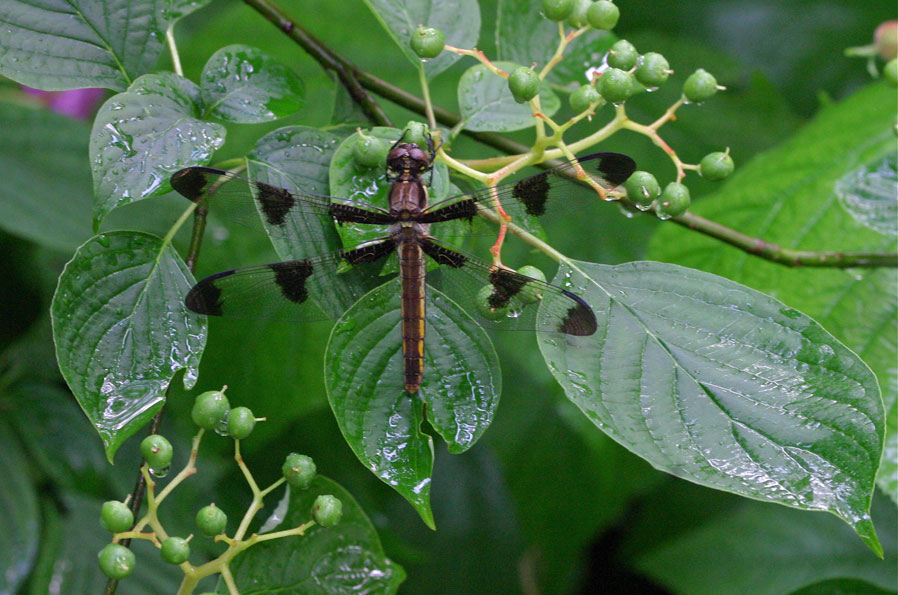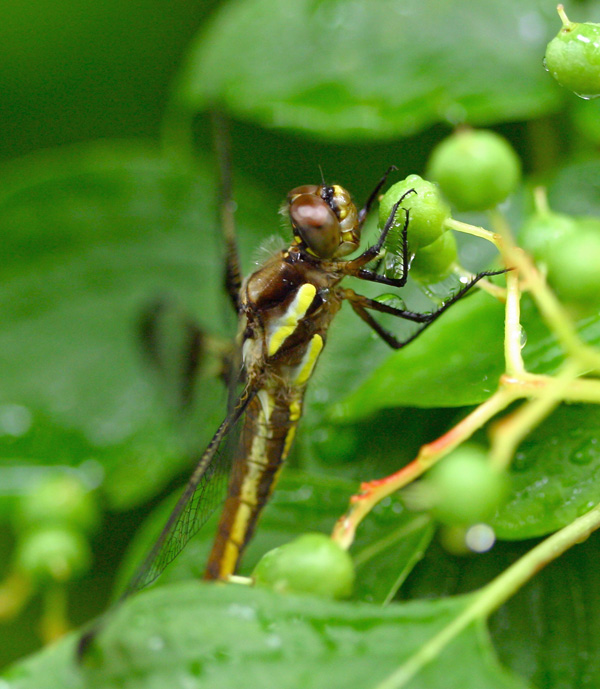A twelve-spotted skimmer (Libellula pulchella) rests on some Pagoda dogwood (Cornus alternifolia ) in my backyard Saturday. © BCP 2010
It wasn’t really a great day to go exploring yesterday — Saturday. Unless, perhaps, you were a duck flying to points east. Two reasons: For 1, it poured rain for most of the day. And 2, it was Day 1 of the G20 summit taking place downtown. A gigantic monkey wrench bollixing up travel through the city core.
My desire to go out and photograph was overwhelming, though. So, as evening was falling, during a slight break from the downpours, I decided to take my camera out into my own backyard — no worries of Black Bloc protesters there — to see what I could see.
As I proceeded down my path quietly and slowly, taking care not to shake water on my camera from the dripping leaves overhead and all around me, in the dimming light I saw something sort of spotted that didn’t quite match the sea of green I was in. I nearly dismissed it, and walked by, but taking another closer look, I realized to my surprise that I was looking at a large dragonfly resting perfectly motionless on some dogwood leaves. Guess it was waiting out the rainy spell before taking off for better hunting grounds. (On its prey list: any soft-bodied insect such as mosquitoes, flies, butterflies, moths, mayflies, flying ants and termites.)
Side view of the twelve-spotted skimmer, Libellula pulchella, showing its bright yellow thoracic stripes. As the males mature, these stripes become obscured with age. © BCP 2010
I attempted to photograph this creature from several angles, but the dim light was causing me problems, and I didn’t want to use my flash. Most of my shots were blurry and out of focus, but I did get a couple that were at least usable enough to make a pretty definitive ID of my odonate.
A quick trip through my Field Guide to The Dragonflies and Damselflies of Algonquin Provincial Park and the Surrounding Area, and I had my ID. The beautiful creature in my yard had to be a twelve-spotted skimmer, Libellula pulchella. Members of the Libellula genus are wide-bodied skimmers with broad wings. They’re often black and white in colouration, including the wings.
Mature males of L. pulchella are easy to identify by the alternating patches of black and white on their wings. Females, however, and immature males lack the white patches on their wings; they only have the 12 black ones.
From the top picture, it’s clear that there are only 12 black spots and no white ones, making my specimen a female or immature male.
The Algonquin Park field guide goes on to say that these dragonflies are usually found near ponds, marshy borders of lakes and slow streams and are actually rare in the park’s highlands and surrounding area. They are much more common south of the Canadian Shield. (But uncommon in my garden.)
With a surprise visit from an unordinary odonate, yesterday became an excellent day all around — G20 protests notwithstanding.
© BCP 2010





1 comment